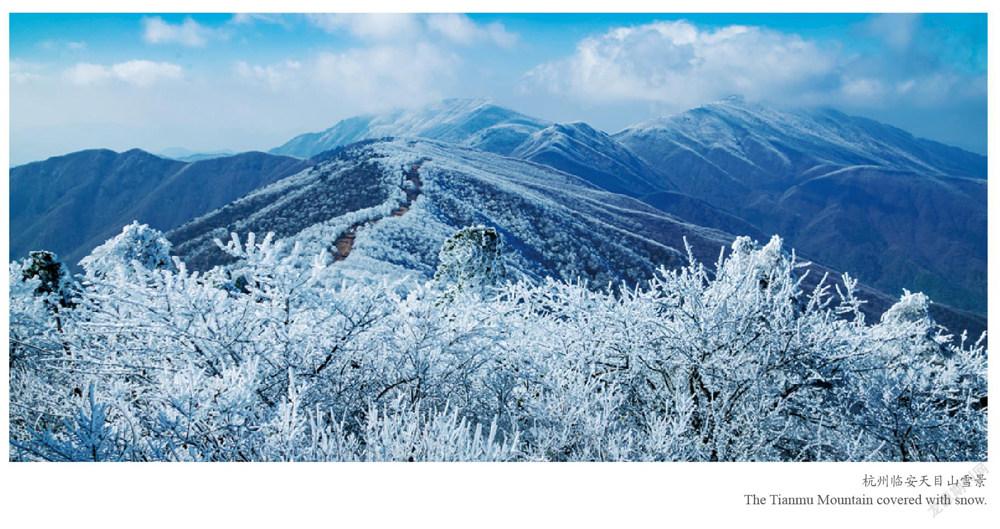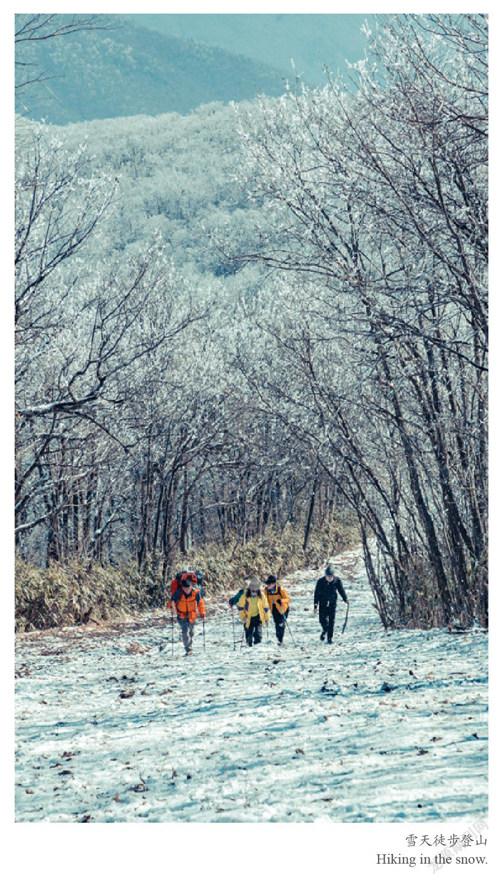赏天目山雾凇 汲取自然力量
阙瑜梦




天目山,古名浮玉山,位于浙江省西北部,主体由东、西两山组成。东天目山主峰大仙峰,海拔1479.7米,西天目山主峰仙人顶,海拔1505.7米,均在杭州临安。
选择进山
如何介绍一座山?我想不出什么好的开头。
如何表达对一座山的热爱?——我想留下来。
大学毕业后,我留在了西天目山,留在了一个叫“大地之野”的自然学校,起因很简单,爬了一次山脊线,捡了两包垃圾,从此过上了与森林四季相伴,看遍春耕夏耘秋收冬藏的生活。
关于天目山的标签有很多,比如国家级自然保护区、全国科普教育基地、全国青少年科技教育基地……
在这里,有“活化石”野生银杏,有“地球独生子”天目铁木,有“会飞的鸽子树”珙桐……在这里,你可以在树下蹲一整天,观察春天枝头上的新芽;你可以手脚并用,攀爬于夏日的怪石林中;你可以捡一片红枫,在手绢上拓印出秋天……而满地的络石种子则预告了冬的风雪,也吹来了蒲公英般的浪漫。
我在冬天来到这里,所以,也想跟你说说冬天这里最有意思的故事。
跨越千年有共鸣
北魏景明元年(500)前后,北魏地理学家郦道元在撰写地理学巨著《水经注》时涉足西天目山,考察山川地理,详载著述,率先发现“山上有霜木,皆是数百年树,谓之翔凤林”。
上面这段话,出自《西天目山志》,初读时,闭上眼睛想象了一番。一千五百年前的一个冬天,郦道元先生徒步于山间,山上的气温要比山下低得多,这令他瑟瑟发抖,哈出的热气在空气中飘散,身边已是白茫茫一片,山上的树木都长满了白色的冰霜,又高又大。不知道是不是凤凰飞过,引得树枝拼命摇摆欢迎,发出了咯吱咯吱的声音。偶尔落下几颗冰霜,配上老木椅般的咯吱声,才叫人感慨——这竟是真实人间。
后来,在某个雨后极寒的冬天,我也爬上了仙人顶,脸颊被冻得通红,呼出的热气在发丝上结了冰,抬头透过雾凇看到了蓝蓝的天空,偶尔飘来的几片云朵像是粘在雾凇枝头的棉花糖,真怕自己的脚印惊扰了这纯白的人间仙境。
雾凇山林有奇观
春花秋月,夏蝉冬雪。雪可以说是冬季最具代表性的自然物了。身处南方的我们常常会因为几片雪花就兴奋不已。
小时候,特别想去北方看看哈尔滨的冰雕、吉林的雾凇。长大后才知道,原来在南方也能看到满山的雾凇,仿佛置身于冰雪世界。
关于“雾凇”一词,最早出现于西晋吕忱所编的《字林》里,其解释为:“寒气结冰如珠见日光乃消,齐鲁谓之雾凇。”这是最早见于文献记载的“雾凇”一词。而在现代,人们也赋予了它很多有趣又好听的名字:
它洁白无瑕,走近一看又毛茸茸的十分可爱,像是怒放在冬天的白色花朵,故称“冰花”;
在万物凋零衰败之时,唯它与风雪战斗,像那高山上的雪莲,凄冷中独自美丽,故称“傲霜花”;
挂在树上的白色松散冰晶,俗称“树挂”,是冰雪挂在了树梢,还是树梢留住了冰雪,光看“树挂”两字,便有了无限的遐想。
雾凇形状主要有两种。一种是雾滴碰到冷的地面物体后迅速冻结成粒状的小冰块,叫粒状雾凇(硬凇),它的结构较为紧密,通常出现在云雾很低的冬季山顶或山谷树木上。另一种是由雾滴蒸发时产生的水汽凝华而形成的晶状雾凇(软凇),结构较松散,稍有震动就会脱落。于是,遇到软凇时,我会蹲在树下,等风来,落下几朵,好似下雪。
雾凇,非冰非雪,是水汽遇冷凝华而成的自然景观。其形成需要很低的气温加上充足的水汽,因条件苛刻,所以不是什么地方都能见得到。
而天目山正好符合这些条件,1500米海拔,冬季气温低,常年水汽充沛,让这里成为一座极美的雾凇山林。冰凇环绕一眼千里,蜿蜒的山脊线,勾勒出冬季最美的景色。
自然会开花
大地之野自然学校在每一年冬季都会开展冰雪主题的冬令营和领略西天目山雾凇之美的登山徒步活动,冬天带着孩子来临安天目山看雾凇、共度亲子时光、创造美好回忆,这似乎成了越来越多80后、90后父母周末和假期的出行选择。
一天中看雾淞的最佳时间是在太阳出来前——5点左右,但是雾凇持续时间较长,主要看当天的风大不大,只要风不是特别大,就可以维持到中午。所以我们大可以在9点出发,边徒步山脊线看雾凇,边做着好玩的亲子小游戏,边寻找冬季的动物痕迹,还可带着这些奇妙的问题:雪地上留下的那串神秘脚印到底来自什么动物?冰天雪地里依然含苞待放的是什么花?林中那些胖得找不到北的是什么鸟?
在大地之野自然学校工作的这些年,遇见了很多有趣的孩子,常常在他们嘴里听到浪漫的话语:“谁说石头不开花,青苔就是它的花”“竹子,只要你抓着,它就会带你去想去的地方”“让种子坐一次毛衣牌公交车吧,我会带着它去其他地方玩耍”“冰雪的世界里,我们可以用魔法消灭坏蛋”……
我们常常在大自然里奔跑,秋天当过树叶床的落叶堆,在冬天也盖上了它白白的“棉被”。我们的双手可以在空气中飞舞,无需顾虑,从山脊高高的一处往下飞奔,有时候会摔一跤,没关系,站起来拍拍裤子衣服,继续向前。
我们的孩子,也可以在雨天踩水,观察松果的开合。在天晴时种下一颗种子,在麻雀叽叽喳喳声中收获稻香。在雪天上自然课,观察雪花的形状,从800米海拔的天空之城徒步到1500米的仙人顶,雪落在山脊线上,我们可以大口呼气,对着大山呐喊。
大自然是如此地公平,也如此地美妙,她带来了春的生机盎然,也送上了冬的银装素裹,绿树会成阴,草木有萧疏。观察一片落叶,寻找动物的痕迹,爬树做秋千,这些“野性童年”,会带给人成长的力量,而在未来,也会多一份感受美好的能力,去面对生活的风风雨雨。
这座山的故事很多,我知道的很少。如果你来到这里,请尽情去感受。在呼吸间便可以获得力量,因为自然會开花。
Tianmu Mountain, a Floating Jade
By Que Yumeng
The Tianmu Mountain, anciently known as fuyu (floating jade), is located at Lin’An district, Hangzhou city in the northwest of Zhejiang. It is mainly made up of two parts: the West Tianmu Mountain, with the 1,497.7-meter Daxian peak as its main Peak; the East Tianmu Mountain, with the 1505.7-meter Xianren Peak as its main peak.
How to introduce a mountain? I am struggling to come up with a smart start.
But how to express my love for the mountain? I suppose the desire to stay is good enough.
So I did. I have stayed at the West Tianmu Mountain after my graduation from college, simply because I went here once for mountain climbing and conveniently picked up two bags of trash along the way. The next thing I know, I am living here accompanied by forests through changing seasons.
The Tianmu Mountain has many titles, such as the National Nature Reserve, the National Popular Science Communication Base and the National Youth Science and Technology Education Base.
Here, you can find wild ginkgo trees — “the living fossil”, iron trees — “the only child of mother earth”, “flying” dove trees and so on. Here, you can spend a whole day squatting under a tree and observing new buds on the branches in spring, or crawl onto different strange big stones in summer; you can pick up a red maple leaf and print an autumn with it on your handkerchief, and learn from the white, furry fallen seeds that a windy, snowy winter as romantic as a dandelion is approaching.
I came here in a winter, so I am going to tell you some winter stories.
In the year 500 during the Northern Wei dynasty (386-534), Li Daoyuan (466 or 472-527), a geographer, set foot on the West Tianmu Mountain during the period he was working on the Zhejiang part of his masterpiece Shuijingzhu (Commentary on the Water Classic). He investigated the geographic conditions of the mountain and its waters, which were then recorded in detail. Also he was the first to discover that “the hoarfrost-covered trees on the mountain were all hundreds of years’ old, which could be collectively given the name of Xiangfeng (flying phoenix) forest”.
Reading this paragraph, I saw in my mind’s eye that on some winter day about 1,500 years ago, Mr. Li was walking in the mountain, shivering from cold as he climbed higher. With his hot breath disappearing into the air, he found himself surrounded by white frosted trees which were all huge and tall. Touched by a flying phoenix perhaps, they wiggled welcome, squeaking like an old wooden rocking chair, and dropped a few ice crystals every now and then — it was totally out of this world.
On a similar freezing winter day over a thousand years later, I also climbed to the top of the Xianren Peak, frozen with red cheeks, and watched my hot breath crystalize on my hair strings. When I looked up through the frosted trees, I saw blue sky embracing sparse white clouds, which were like marshmallows stuck to the tree branches. This was a holy world of pure white, where I dare not to step inside and leave a stain.
It is safe to say that snow is the most representative natural sign of winter. Living in South China, we are easily thrilled by a little pieces of snow flakes and always longing for the ice sculptures and the rime in Northeast China as a child. But now as a grown-up, I get to know there is also a world of ice and snow hidden up on the mountain in the warm south.
When it comes to the word wusong (rime), it first appeared in a written record of Zilin (Forest of Characters), a Chinese dictionary compiled in the Jin dynasty (265-420) by Lü Chen. Nowadays, it has also been given many lovely and interesting names, such as ice flower, lofty frost flower and icicle.
There are two major shapes of rime. One is called granular rime (or hard rime), which has a relatively compact structure and usually appears in winter on a mountain top with low clouds and fogs or on the trees grown in valleys. The other is called crystalline rime (or soft rime) which is structured loosely and tends to fall off under a slightest shake. So whenever I spot soft rime on the tree, I will squat down and wait for a wind to gently blow it off like falling snow.
Rime, neither ice nor snow, is a natural landscape formed by vapor which condenses on a cold surface. And that strictly requires a very low temperature with sufficient vapor hence not commonly seen in nature. Fortunately, the Tianmu Mountain perfectly meets all the requirements with its 1,500-meter height, extremely low temperatures in winter, and a yearly abundant supply of vapor. It boasts of a breath-takingly beautiful winter of stunning rime forests and a rolling ridge covered in ice and snow.
I work in the Wild Earth Natural School, which organizes an annual ice-and-snow-themed winter camp, and offers climbing and hiking opportunities for children to search for rime in the West Tianmu Mountain. This has become an increasingly popular choice among young parents for happy family time on weekends.
The peak time for exploring rime scenery is before sunrise — about five in the morning. But thanks to its long-lasting nature, this scenery could stay safe and sound until noon as long as it is not terribly windy. In that case, starting off at nine is also acceptable. While hiking and rime spotting, we can also play some parent-child games for fun and keep an eye for traces left by wild animals with curiosity.
I have met a lot of interesting kids while working here at the school, who often talk with romantic innocence. So I couldn’t help thinking that it is a childhood in the wilderness that fills our children with strength in their growth, cultivates their ability to search and appreciate the beauty around them and prepare them for the possible trials and hardships in the future.
The Tianmu Mountain knows many stories, of which I know only partly. If one day you have a chance to come here, please try to feel and breathe as hard as you can to taken in some power from nature.

